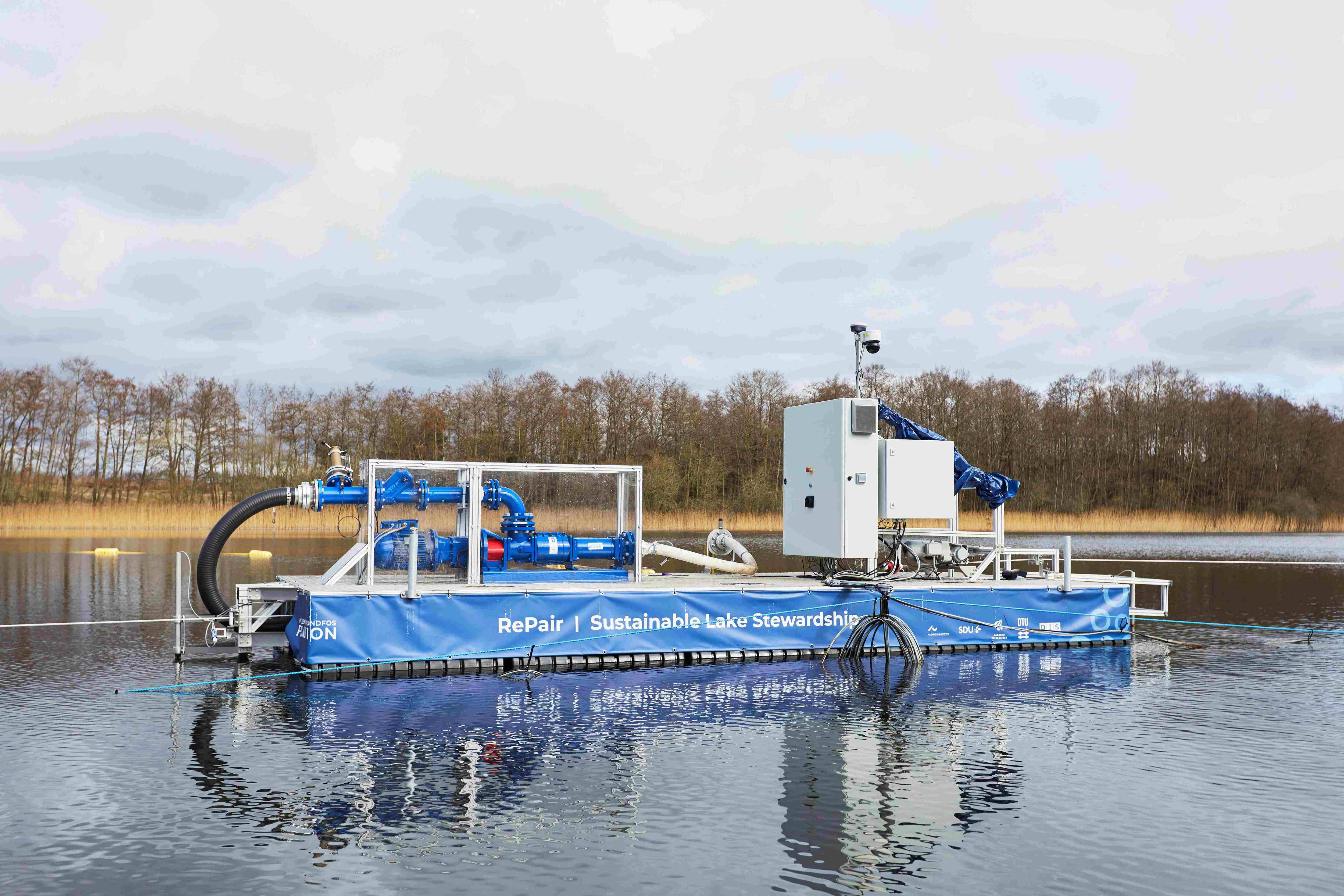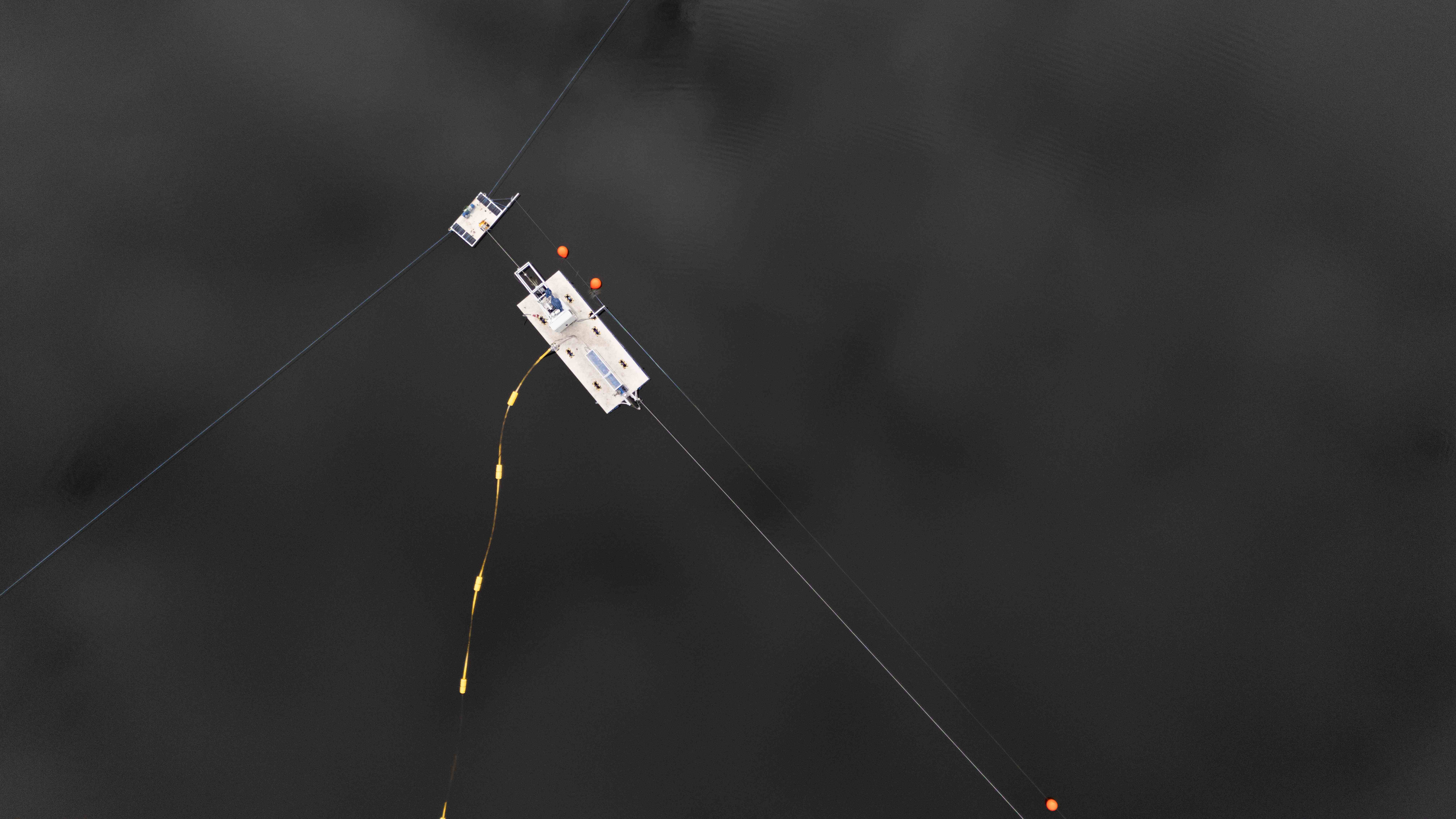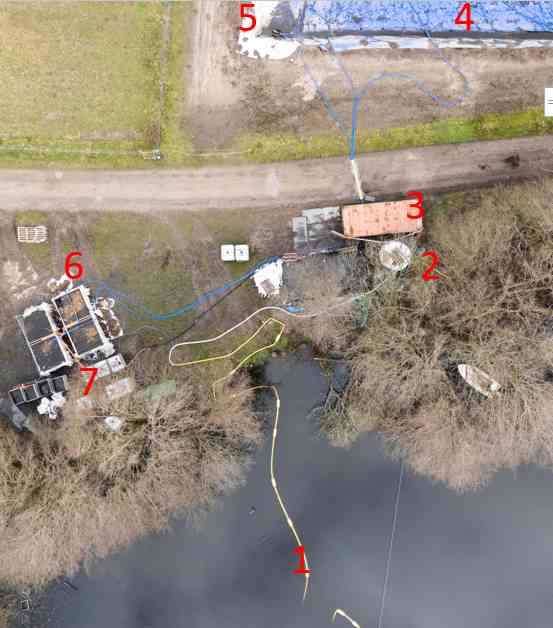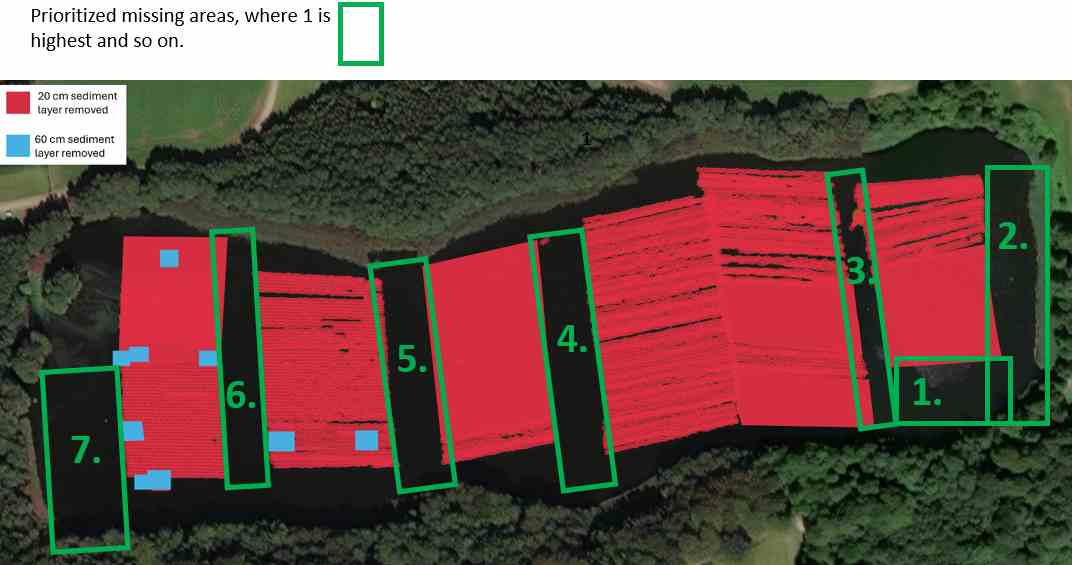
The Objectives: |
For more details please refere to the following description. |
The Results: |
|
WP1 - Dredging and Pumping of Sediment.
Participants
DIS
Description
Sediment dredging is an established method to maintain the natural depth in ports and waterways of water and marine channels. It is estimated that over 200 million m3 of sediment are dredged every year in Europe (EMODnet, 2017). Furthermore, sediment dredging is routinely used for lakes, as sediment can be a source of contaminants for the water column of the lake, which includes nutrients such as P (Zhang et al. 2021). Sediment with high accumulated amounts of P can act as a buffer to changes in the lake concentration of P (Zamparas and Zacharias 2014). The P movement and recycling between sediment and water column is generally a problem for lake restoration and simple reduction of the P loading without managing the P pool in the sediment is not enough to reverse the impaired water quality (James 2016) and therefore dredging is a useful method to remove this internal P pool. Nonetheless, dredging can disturb lake ecosystems; disturb P within the sediments, unintentionally releasing it into the water column, while also being a source of GHG, with the process releasing methane gas trapped within the sediment during both dredging and storage (Gebert et al 2019). Therefore, timing and dredging practice needs to be carefully considered. The P content in lakes with high P load is usually high at the top of the sediment layer and large amounts of P are released to the lake water (Søndergaard et al 2015, Li et al 2020 James 2016). In Lake Ormstrup, experimental data have shown that the P release can be reduced with >90% by removing 40 cm of the sediment (Søndergaard et al 2015). Other studies confirm that sediment dredging can reduce long term release of P from the sediment (Chen et al 2018).
Different technologies exist for dredging, and the technologies are often divided into two subgroups: mechanical dredgers and suction dredgers. Some examples are grab dredgers, auger dredgers e.g. Mud Cat (www.mudcatdredge.com) and the cutter suction dredger e.g. Van Oord (www.vanoord.com), but there is a long list of different available technologies. The optimal type of dredging technology depends on a range of parameters, including the size of the lake, lake depth, amount of sediment, consistency of the sediment. Lake sediment often has a high content of organic matter and differs from marine sediment in the sea water system with high salinity (Zhang et al 2021). Thus, suction dredging seems to be the most promising method, but different technologies will be evaluated as part of the project. The priority is to remove accumulated P in the sediment with minimal disturbance to the lake ecosystem.
The dredged sediment has to be transported to land for further handling. The shear due to pumping may destroy the structure of the sediment, and the introduction of air may change the redox potential, whereby more polymers are required before dewatering. Thus, gently pumping is best for the further handling of sediment. The problem with high shear stress is well-described for other systems, e.g., wastewater sludge (Christensen et al. 2015), but not investigated for dredged sediment.
Objectives
- Identify or develop technology for lake dredging with minimal disturbance of the lake ecosystem and gas emission
- Develop a method to gently transport the sediment on land
- Remove 20 cm sediment in Lake Ormstrup for >80% of the lake area
Activity
WP1 will be executed through four main stages and based on close interaction with key project partners.
Task 1.1: Pre-study: Analysis and ideation
Based on existing data from Lake Ormstrup, it will be determined how thick a layer of sediment that must be removed and whether it is the whole lake or part of the lake that has to be treated. This task will take the form of an agile pre-study and will be executed with an agile sprint approach.
The initial focus will be on establishing the vision and identifying relevant technologies, their maturity and related project deliverables. I.e., the most commonly used dredging methods will be identified and evaluated. The outcome of the task will be a validation of promising technologies and a recommendation of scenarios for further conceptualization.
Success criteria: At least one high-level concept for dredging will be identified
Task 1.2: Concept development of dredging, pumping and dewatering solution
A fail-fast strategy will be applied during the conceptual development. This means that partial tests will be performed on promising opportunities with the purpose of reducing uncertainty as early as possible by matching theory with facts.
The most promising dredging methods will be tested at pilot scale facilities at DIS, focusing on the disturbance of the lake by visually (video) monitoring of the water column above the dredged sludge during and after dredging eventually by measuring P content and particle concentration.
Dredged sludge will be dewatered using the facility at DIS with at least three synthetic polymers and five biopolymers will be tested to determine the required dosage of polymer and the effect of mixing (collaboration with WP2). Dredged sediment (>100 L) will be stored so it can be used for tests in WP 4, 5 and 6. Filtrate after dewatering will be collected (>100 L) and stored so it can be used for tests in WP3.
Success criteria: At least one concept with system architecture and description will be developed and specified to the required level. An updated project plan (schedule, risk and budget) for detailed development, production and implementation has been developed.
Task 1.3: Production of system solution
Further development, test and simulation of a detailed system will be part of this task. At least one concept will be further detailed, built, and tested. Subsequently, components will be sourced and/or produced for assembly, test and verification of final system solution at DIS and/or sub-suppliers.
Success criteria: at least one functional solution has been sourced, produced, and assembled. The solution has been verified and is ready for implementation.
Task 1.4: Implementation of dredging, pumping and dewatering solution at lake Ormstrup
Full-scale equipment will be installed at Lake Ormstrup for dredging, pumping, and dewatering based on the design from the previous task. Removing 20 cm of the sediment in >80% of the lake results in 19200 m3 sediment, plus additional water. The sediment will be removed over a period of up to six month, filtrate will be returned to the lake and sediment handled. It is expected that the amount of sediment after mechanical dewatering is <6500 m3.
It will be ensured that a side stream can be taken out prior to the dewatering process for supplementary experiments in WP2. The filtrate will be either returned to the lake or supplied for future treatment e.g. electrodialysis at pilot scale (WP3).
Success criteria: A full-scale solution is installed and running at Lake Ormstrup
WP structure
DIS will drive the innovation part in the WP. Cooperation, knowledge sharing, and learning will be central throughout the development steps in the work package. This also means that project partners proactively have an influence on the weighting and selection of technologies and later development and implementation of the final dredging solution.
Risks associated with work package
Conditional changes to work package plan (budget, time and risks) due to man-hour and/or material cost. The work package has a clear focus on the challenges initially pointed out. Find solutions and evaluate technologies, well knowing that the cost and time perspectives of the different solutions can be very different and require evaluation during phases and planning process.
DIS will seek to mitigate risk by providing an understanding of how the different solution scenarios and maturity will affect the solution to be developed in relation to cost, time and risk. The solution and development process are required to be refined and evaluated at scheduled phase events.
Path to commercialization
For lake restoration applications, WP1 will bring a pumping/dredging solution to TRL7 and consider opportunities for the scalability of one or more concepts.
WP1 will not incorporate the technology in a commercial design as well as evaluate suppliers/partners long term commercial viability. This means that when reaching proof of concept, the project will not deliver commercial proof. Should there be a need for commercial proof of the concept, this will have to be provided in later projects.
The Results
To fulfill the requirements regarding dredging with minimal disturbance of the lake ecosystem and gas emission the Lakebot was invented.
Traditional restoration methods
Traditionally, lakes are restored by either excavation or the addition of aluminum. Both are intense interventions that can have a negative impact on the lake’s ecosystem.
Excavation removes parts of the sediment layer, but rarely the volatile part, and the result is short-term effects.
By adding aluminum, the phosphorus is held on the lakebed.
The Lakebot – a “suckerbot” with unique properties
Like a robotic vacuum cleaner, the system controls itself and finds the lake bed’s critical sediment layer with high precision. The operation is quiet and gentle.
The specially designed suction head gently removes the nutrient-rich sediment layers. The suction head works gently through the soft layer of bottom sediment without mechanical stirring and murky lake water.
Benefits
RePair technology is a new method that reduces the impact on the environment.
It is an autonomous system that does not require permanent staffing.
The goal is a gentle, cost-effective dredging process.
The Lakebot is amongst others equips with GPS, echo sounders, turbidity sensor and underwater camera.
Propulsion is done by a capstan winch using that is winching on a rope (the X-axis). The X-axis is attached between two floating end-stops (the Y-axis), that gives the possibility to move the Lakebot after each dredged lane. With this concept it is possible to let the Lakebot run autonomously.

Develop a method to gently transport the sediment on land
To move thes sediment in a gentle way to the shore, the sediment was pumped via a hose to land, where the following set-up was created.
 |
From dredger (1) to buffer tank (2) From buffer tank to container (3) From container (polymer) to GeoTubes (4) From GeoTubes (reject water) to pond (5) From pond to sand filter (6) From sand filter to water for polymer mix or to the lake (7)
Capacity: 40m3 per hour. Time lap: 8 to 12 hours – eventually 24/7 |
Remove 20 cm sediment in Lake Ormstrup for >80% of the lake area
The total amount of removed sediment is less than 80 % - see picture below. An additional bennefit of the Lakebot came to show based on the request to dig out seedbanks situated 60 cm belowe in the sediment. This was done successfully. The areas are marked with blue in the picture.

